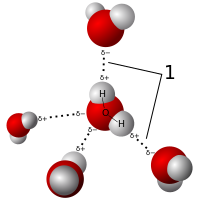
Photo from wikipedia
Abstract With the aid of differential phonon spectrometrics (DPS) and surface stress detection, we show that HI and NaI solvation transforms different fractions of the H O stretching phonons from… Click to show full abstract
Abstract With the aid of differential phonon spectrometrics (DPS) and surface stress detection, we show that HI and NaI solvation transforms different fractions of the H O stretching phonons from the mode of ordinary water centred at ∼3200 to the mode of hydration shell at ∼3500 cm −1 . Observations suggest that an addition of the H ↔ H anti-hydrogen-bond to the Zundel notion, [H(H 2 O) 2 ] + , would be necessary as the H O bond due H 3 O + has a 4.0 eV energy, and the H ↔ H fragilization disrupts the solution network and the surface stress. The I − and Na + ions form each a charge centre that aligns, stretches, and polarize the O:H O bond, resulting in shortening the H O bond and its phonon blue shift in the hydration shell or at the solute-solvent interface. The solute capabilities of bond-number-fraction transition follow: f H = 0, f Na ∝ C, and f I ∝ 1 − exp(−C/C 0 ) toward saturation, with C being the solute molar concentration and C 0 the decay constant. The f H = 0 evidences the non-polarizability of the H + because of the H ↔ H formation. The linear f Na (C) suggests the invariance of the Na + hydration shell size because of the fully-screened cationic potential by the H 2 O dipoles in the hydration shell but the nonlinear f I (C) fingerprints the I − ↔ I − interactions at higher concentrations. Concentration trend consistency between Jones–Dole’s viscosity and the f NaI (C) coefficient may evidence the same polarization origin of the solution viscosity and surface stress.
Journal Title: Vibrational Spectroscopy
Year Published: 2018
Link to full text (if available)
Share on Social Media: Sign Up to like & get
recommendations!